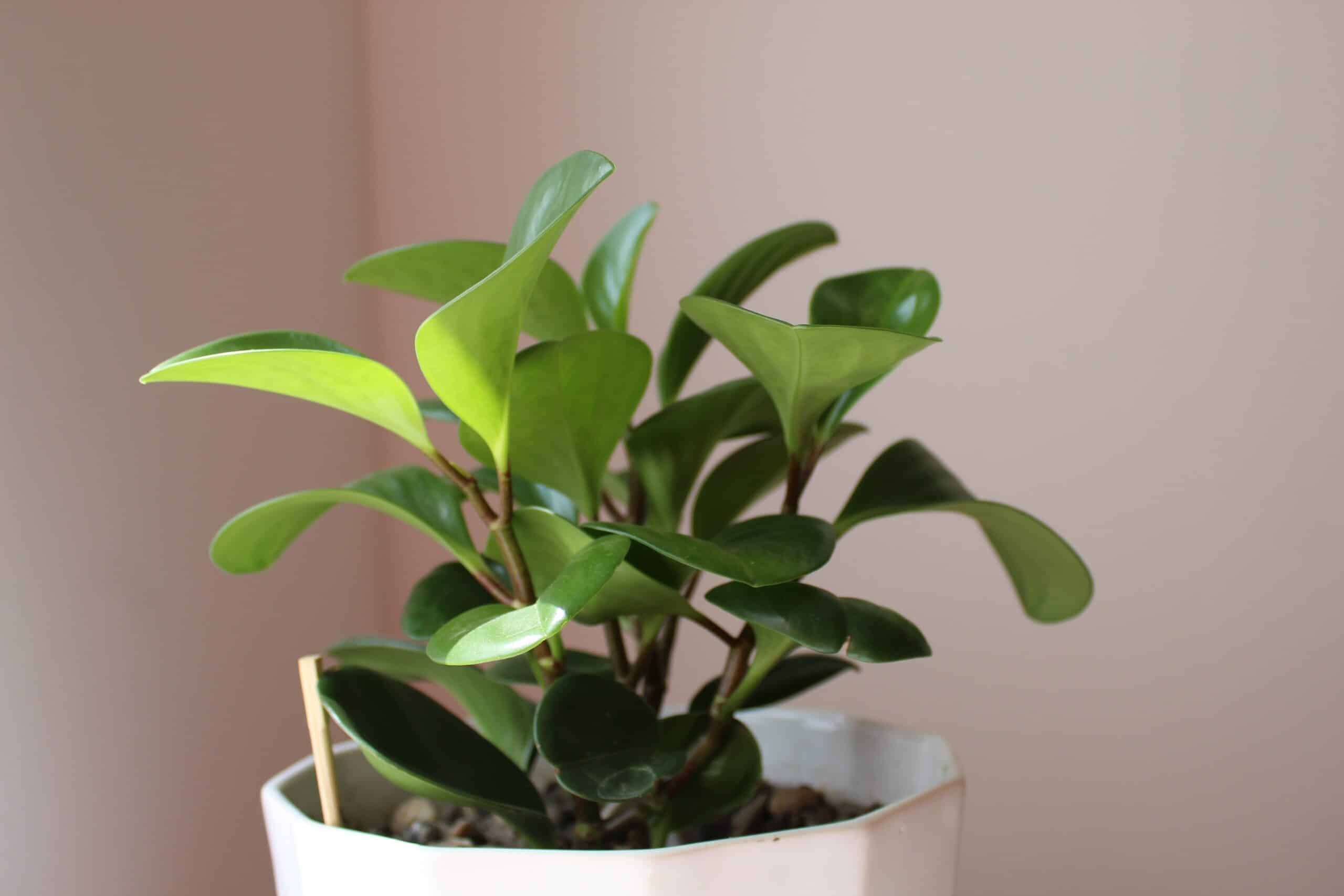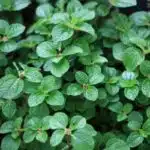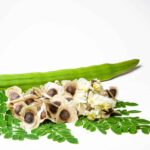It’s easy to think that tending to a houseplant is too much for the average person. After all, it seems like there are so many things to know and keep track of – water, fertilizer, sunlight. But believe it or not, growing the Peperomia obtusifolia (Baby Rubber Plant) is actually much simpler than you might think!
This article will make caring for your Baby Rubber Plant a breeze. From watering schedules to temperature requirements, we’ll cover everything you need to know in order to get started on your green thumb journey. Plus, if you already have some gardening experience under your belt, then this guide will help you take it up a notch.
The Peperomia obtusifolia is an easy-care indoor plant that stands out from the rest with its unique foliage and bright yellow flowers. Not only does it look great in any room in your home or office, but its air-purifying abilities can help keep indoor air clean and fresh. So what are you waiting for? Read on and let’s get started on taking care of this amazing houseplant!
Overview Of Peperomia Obtusifolia
Peperomia obtusifolia, also known as Baby Rubber Plant, is a wonderful addition to any home or office. It’s an evergreen perennial that grows up to 12 inches in height, with upright stems and small oval-shaped leaves that come in many colors. This plant is perfect for adding a touch of greenery indoors or out, and it’s very easy to care for!
When it comes to sunlight, Peperomia obtusifolia doesn’t require much – bright indirect light is best. Watering can be done every two weeks or so when the top layer of soil feels dry. Be careful not to overwater as this could lead to root rot. Fertilizer should be applied monthly during the growing season with a balanced liquid fertilizer diluted to half strength.
Peperomia obtusifolia is a beautiful plant that can easily fit into any home or office decor. With minimal effort, you’ll have a vibrant addition to your space that will last for years! Now let’s take a look at planting and repotting your Baby Rubber Plant so you can enjoy its beauty in no time!
Planting And Repotting Your Baby Rubber Plant
Peperomia obtusifolia, also known as the baby rubber plant, is an easy-to-care-for houseplant that’s loved by many. Of all plants, over 86% of gardeners reported having a baby rubber plant in their home or garden! Planting and repotting your baby rubber plant are simple processes that will help it grow healthy and thrive.
When planting your peperomia obtusifolia, start with a potting mix that has good drainage capabilities. You can find special potting mixes for succulents and cacti at most local nurseries or gardening stores. Then, place the pot in an area with bright indirect light and water every 2 weeks. To ensure the soil is moist without becoming soggy, wait until the top two inches of soil are dry before watering again.
When repotting your peperomia obtusifolia, make sure to: • Choose a pot size approximately two inches wider than the current one
- Use well-draining soil
- Remove any old/dead roots before replanting • Place new soil into the bottom of the pot
- Gently remove the root ball from its original container
- Place onto new soil in the larger container and press gently around it to secure it in place • Water thoroughly after planting and let excess water drain out
When caring for this type of plant, proper light requirements are key. Too much direct sunlight can burn or wilt its leaves while too little light can cause stunted growth. Keep this in mind as you move forward with providing appropriate lighting for your baby rubber plant.
Light Requirements For Peperomia Obtusifolia
Caring for a Peperomia obtusifolia (baby rubber plant) has been the highlight of Maria’s day. She loves watching her plant thrive and grow, but knows that it requires the right environment. To ensure that her baby rubber plant is receiving the correct amount of light, she has paid careful attention to the light requirements of Peperomia obtusifolia plants.
Lighting is an essential factor when it comes to caring for a baby rubber plant. While they are not difficult to care for, they do require bright, indirect light in order to flourish. Too little light can cause their leaves to become pale or yellow, while too much sun can burn their leaves. Ideally, you should place your baby rubber plant near a window that receives plenty of natural light without direct exposure to sunlight.
When growing a baby rubber plant indoors, it’s important to keep track of how much sunlight it receives on a daily basis. A few hours per day of direct sun is acceptable as long as you adjust the distance from the window as necessary depending on the time of year and weather conditions outside. In addition, using artificial lighting such as LED grow lights can also be beneficial in providing additional brightness if needed.
By taking these steps and providing your Peperomia obtusifolia with adequate lighting, growth and health can be achieved easily and efficiently. Next up will be addressing soil requirements for this popular houseplant species so that it continues its journey towards becoming an even bigger statement piece in Maria’s home!
Soil Requirements For Peperomia Obtusifolia
Soil is the lifeblood of any plant, and that goes double for a Peperomia obtusifolia. Like most plants, this baby rubber plant has some pretty specific soil requirements in order to thrive. If you’re looking to keep your little friend happy, read on to discover what your Peperomia obtusifolia needs from its soil.
First off: drainage is key! This plant loves a well-draining soil mix – think something along the lines of two parts peat moss or coco coir with one part perlite or sand. This will help it grow optimally and keep it healthy over time. You can also add a small amount of compost or fertilizer to give it an extra boost of nutrition.
In terms of pH level, Peperomia obtusifolia does best in slightly acidic soil – around 5.5-6.5 is ideal for this species. If you’re unsure about the pH level of your potting mix, you can purchase testing kits online or at most garden centers that will help you determine whether you need to adjust anything before planting your baby rubber plant.
With these tips in mind, your Peperomia obtusifolia should have everything it needs from its soil to have a happy and healthy life with you! Now let’s look at the temperature requirements for this lovely little houseplant.
Temperature Requirements For Peperomia Obtusifolia
Temperature requirements are one of the most important factors in helping your Peperomia obtusifolia thrive. These plants prefer consistently warmer temperatures, which is why they’re often found growing indoors. They tend to do best in temperatures between 65-75°F, but can handle a bit cooler or warmer if needed. If you’re looking for an easy to care for indoor plant that doesn’t need a lot of fussing over, this could be the perfect choice for you!
When it comes to temperature fluctuations, it’s important to remember that these plants prefer gradual changes rather than sudden ones. Keeping your Peperomia obtusifolia away from drafts and cold windowsills should be top priority. It’s also important to note that these plants don’t tolerate extreme heat well either, so try to avoid placing them near any sources of direct sunlight or other intense heat sources.
Peperomia obtusifolia need consistent temperatures and minimal fluctuations in order to stay healthy and reach their full growth potential. If you provide it with everything it needs–the right soil, light levels and temperature–you will be rewarded with a happy and thriving plant! Now that we’ve covered the temperature requirements for Peperomia obtusifolia, let’s move on to discussing watering needs for these beautiful houseplants.
Watering Requirements For Peperomia Obtusifolia
What a paradox! Our cute, little Baby Rubber Plant needs lots of attention when it comes to watering and temperature requirements. Fortunately, with just the right amount of effort, you can keep your Peperomia obtusifolia happy and healthy. Let’s look at how to water it properly.
Watering your Peperomia obtusifolia is key to keeping it vibrant and thriving. When watering this plant, make sure that the soil is evenly moist but not soggy. Water when the topsoil feels dry to the touch; this could be anywhere from once every 7-10 days in warm weather or once every couple of weeks in cooler temperatures. Be careful not to over water since this can cause root rot, which will harm your plant’s growth and health.
It’s also important to remember that Peperomia obtusifolia likes humidity; so if you’re growing your baby rubber plant indoors, a humidifier or frequent misting will be beneficial for its growth. If you are planting outdoors, try planting in a spot where air circulates well so that excess moisture doesn’t build up near the plant’s roots. By following these simple steps and using the right balance of water and humidity, you can help ensure your Peperomia obtusifolia grows successfully. Now let’s move on to fertilizing this beautiful houseplant!
Fertilizer Requirements For Peperomia Obtusifolia
Ah, the timeless beauty of a peperomia obtusifolia (baby rubber plant) – its lush foliage, its vibrant green leaves, and its effortless versatility. To ensure it continues to thrive in your home, though, there’s one more step that needs to be taken – fertilizing!
Fertilizing your baby rubber plant should be done during the growing season when roots are actively developing; usually this is from early spring to late summer. Aim for a balanced fertilizer with equal parts nitrogen, phosphorus, and potassium. Avoid using too much fertilizer as you don’t want to burn the plant’s roots. A good rule of thumb is to apply about half of the recommended amount on the package instructions.
If possible, use an organic liquid fertilizer or diluted slow-release granules once every two weeks or so. If you notice that your baby rubber plant isn’t growing as quickly as it should be, increase application to once a week until you see new growth. As always, make sure you water before applying any fertilizer and always follow the instructions on the label for best results.
Now that your baby rubber plant’s fertilizer requirements have been checked off the list, it’s time to move onto pruning and trimming for optimal health and vitality.
Pruning And Trimming Your Baby Rubber Plant
Ahh, pruning and trimming your baby rubber plant. You think to yourself: why not just let it grow wild and free? Who are you to prune and trim this innocent little being? Well, don’t fret – if done right, pruning and trimming can actually help your plant flourish!
First off, you’ll want to use a nice pair of scissors or pruners when you’re cutting back on your baby rubber plant. If your plant needs a major pruning session (e.g., it’s grown too tall) then it’s best to cut the stem back by about two-thirds of its original size. This will encourage more growth from the lower part of the stem. Also, be sure to clean the tools you’re using before and after each cut!
When it comes to trimming away any dead leaves or stems, it’s important to only remove what needs removing. If there are any yellowing leaves at the bottom of your plant, these can safely be removed as they won’t be getting any sun anyway. Additionally, try not to pull off any leaves that still look healthy – instead use a scissors or pruners to make a clean cut right above the base of the leaf.
TIP: Always remember that when pruning or trimming your baby rubber plant, less is more! Don’t go overboard with cutting back too much – as this could harm or stunt the growth of your precious little plant!
Controlling Pests & Diseases On Peperomia Obtusifolia
Did you know that an estimated 60% of houseplants are prone to pests and diseases? With proper care, however, many of these issues can be avoided or solved. Controlling pests and diseases on peperomia obtusifolia (baby rubber plants) is essential for keeping the plant healthy and thriving.
Firstly, it’s important to check your baby rubber plants regularly for signs of disease or pest problems. Identifying the issue early can help reduce the severity of any damage caused by pests or diseases. Common pests include mealybugs, scale insects, aphids, and spider mites. Diseases may include root rot, leaf spot, and gray mold.
It’s also important to practice good hygiene when caring for your peperomia obtusifolia. This includes removing dead leaves and damaged stems as soon as possible to avoid infestations from pests or spread of disease. Additionally, use insecticidal soap or neem oil to get rid of common pests like mealybugs or aphids. Avoid using chemical insecticides if possible as they can be harmful to plants and humans alike.
By taking preventative measures such as keeping a watchful eye on your baby rubber plant and practicing good hygiene habits in its care, you can control most pest and disease issues before they become more serious problems. Now let’s look at how we can propagate this popular houseplant!
Propagating Peperomia Obtusifolia
Propagating peperomia obtusifolia (baby rubber plant) isn’t as hard as it seems. It’s a great way to increase your collection of this beautiful and unique houseplant. Here are some easy steps to take for successful propagation:
Start with stem cuttings from an existing healthy plant. Make sure the cuttings have several leaves on them, and then remove any that are wilted or discolored.
Place the cuttings in a jar of water so they can root there. You don’t need to add anything else: just keep it in a bright spot away from direct sunlight and change out the water every few days.
Once the roots have grown about 2 inches, you can transplant them into soil-filled containers. Use one that’s at least 4 inches deep, and make sure it has drainage holes at the bottom.
When transplanting, be sure to use loose, well-draining potting soil mixed with compost or perlite for added aeration. After planting, give your new baby rubber plants plenty of indirect light until they start growing again.
You now have multiple plants from one original! With proper care and attention, these will grow into healthy specimens in no time. And who knows — maybe you’ll end up giving some away as gifts! Let’s move on to common problems with peperomia obtusifolia so you can ensure that your new plants stay healthy and thriving.
Common Problems With Peperomia Obtusifolia
At times, even the most experienced gardeners struggle to care for their plants. Peperomia obtusifolia, commonly known as baby rubber plant, is no exception. While this resilient plant can thrive with minimal care, it can also suffer from common problems like root rot, yellowing leaves, and wilting.
Root rot occurs when a plant’s roots don’t get enough oxygen and become submerged in water. This causes the roots to break down and die which can result in yellowing leaves or wilting of the entire plant. To prevent root rot, make sure that your peperomia obtusifolia is planted in well-draining soil and avoid overwatering.
Yellowing leaves are another common problem with peperomia obtusifolia. Generally, yellowing leaves indicate a nutrient deficiency or too much sunlight exposure for the baby rubber plant. To remedy this issue, use a balanced fertilizer to ensure that your plant is getting enough nutrients and adjust its light exposure accordingly.
With proper care, you can ensure that your peperomia obtusifolia stays healthy and happy for years to come. Armed with these tips for addressing common issues with baby rubber plants, you’ll be ready to provide the best possible environment for your beloved greenery!
Tips For Growing Peperomia Obtusifolia
Now that you’ve got a handle on the basics of growing peperomia obtusifolia, let’s take a look at some tips to help you get the most out of your baby rubber plant. With just a few simple tricks, you can become an expert in no time!
First off, make sure to water your plant regularly. Aim for once or twice per week depending on the temperature and humidity level of your home. Peperomia obtusifolia also really loves bright light, so try to place it near a window with ample direct sunlight. If needed, use sheer curtains or blinds to reduce the intensity of the sun’s rays without blocking them completely.
It’s also important to provide your baby rubber plant with plenty of air circulation and humidity. A fan pointed in its direction will do wonders for keeping air moving around it, while a humidifier can help keep the environment properly moistened. Additionally, consider misting your plant every so often to give it an extra boost of hydration!
Finally, repotting is essential if you want your Peperomia obtusifolia to reach its full potential. Try doing this every year or two using a potting mix specifically designed for succulents and cacti plants. Doing so will ensure that your baby rubber plant has access to all the nutrients it needs during its growth cycle!
Benefits Of Growing Peperomia Obtusifolia
Growing peperomia obtusifolia (Baby Rubber Plant) is a rewarding experience that comes with numerous benefits. It’s like winning the lottery – you get to enjoy lush foliage, vibrant colors, and a natural air purifier all in one package! Here are some of the advantages of growing this beloved houseplant:
• Aesthetic Appeal: Peperomia obtusifolia plants are visually stunning with an array of green, yellow, and red hues. It’s sure to add an exotic touch to any home or office.
• Easy Maintenance: This plant requires minimal care and attention yet still looks great. With regular watering and occasional pruning it will thrive for years to come!
• Air Purification: Peperomia obtusifolia helps filter out harmful toxins from the atmosphere which can improve air quality in your home or office.
These are just a few of the many benefits to owning this beautiful plant. Plus, it can be used in a variety of ways such as terrariums, potted arrangements, or even as hanging baskets! With so much potential for creativity and style, it’s no wonder why peperomia obtusifolia is such an attractive option for gardeners everywhere. Now let’s explore how this plant can be used around the house or office.
Uses For Peperomia Obtusifolia
Uses for Peperomia Obtusifolia can be found in many areas of our lives. Firstly, these plants are popular as houseplants due to their low maintenance needs and attractive foliage. Secondly, they provide an easy-to-care-for option for those looking to add a touch of greenery to any room. Here is a list of ways you can use this plant:
• Decoration:
- In the home: Place it in your living room or bedroom to bring a bit of nature indoors.
- In offices: Use as an office desk or shelf decoration for a pop of color and life. • Food/Medicine:
- In cooking: The leaves contain essential oils that can be used as an herb in dishes and drinks.
- In medicine: Its leaves have been used traditionally to treat digestive issues such as indigestion and constipation.
The versatility of peperomia obtusifolia means that it is suitable for both indoor and outdoor spaces, making it a great choice for any gardeners looking for an easy-to-care-for plant with multiple uses. With its striking foliage, this plant will be sure to add beauty and charm to any space! Now that you know about the uses for peperomia obtusifolia, let’s move onto troubleshooting any potential issues you may come across with this plant.
Troubleshooting Peperomia Obtusifolia
When it comes to growing the Peperomia Obtusifolia, also known as the Baby Rubber Plant, there are many things that can go wrong. Knowing what to do when trouble arises is a must-have for any plant enthusiast. As such, this article will provide some troubleshooting tips for those looking to cultivate their own Baby Rubber Plant.
It’s important to keep an eye on your plant’s health. If you notice yellowing leaves or wilting stems, try repotting the plant into a larger pot and check the soil to make sure it’s not too soggy or dry. Additionally, make sure your Peperomia Obtusifolia is getting enough light and water; too much of either can be detrimental. Make sure that the temperature stays between 65-75 degrees Fahrenheit and keep the humidity at around 50%.
Keeping pests away from your Baby Rubber Plant is also essential for its continued health. Common insects like aphids, mealybugs, and scale can wreak havoc on plants if not taken care of in a timely manner. To get rid of these pests, mix some mild soap with water and spray it directly onto them; or you could use a horticultural oil spray instead. Whatever method you choose, make sure to act quickly and thoroughly so that they don’t return!
With proper care and attention, your Peperomia Obtusifolia will soon be thriving! By following these troubleshooting tips, you’ll be able to help your plant stay healthy while avoiding any potential problems along the way. So take a deep breath – with patience and dedication you should have no problem ensuring success with your Baby Rubber Plant!
Frequently Asked Questions
How Long Does It Take For Peperomia Obtusifolia To Grow?
Growing a peperomia obtusifolia plant is like nurturing a baby – you have to be patient and consistent. Picture a tiny seedling slowly uncurling its leaves and unfurling its stem, blossoming into something beautiful with the right care. Watching it grow is a rewarding experience that can take anywhere from six months to two years depending on your environment.
To help speed up the process, there are certain steps that you can take to ensure your baby rubber plant flourishes. Firstly, it’s important to provide your peperomia obtusifolia with the right amount of light, water and humidity. To mimic its natural habitat, make sure you place it in bright but indirect sunlight and keep the soil moist but not sodden. Secondly, fertilize your plant every month or two using an organic fertilizer or one designed specifically for houseplants. Lastly, exercise good hygiene habits such as wiping down the leaves with lukewarm water if they get dusty or misting them occasionally if the air is too dry.
With these simple tips in mind, you’ll be able to nurture your peperomia obtusifolia into a lush and vibrant addition to your home! With patience, consistency and some TLC you can look forward to watching it grow into an eye-catching display of glossy green foliage for all to admire.
How Often Should I Water My Baby Rubber Plant?
You reap what you sow” is an adage that aptly applies to the caring of your baby rubber plant (Peperomia obtusifolia). Like any other living thing, your peperomia requires proper tending in order to thrive. Chief among its needs is proper watering – how often should you do it?
In general, peperomias are not heavy drinkers, but they do need regular hydration. Here’s a few tips on how to keep your baby rubber plant healthy: • Let the soil dry out somewhat between waterings. If the top inch or so of soil is dry, it’s time to water. • Don’t overwater; too much water can quickly cause problems such as root rot and leaf drop. • In winter, reduce the frequency of watering even further than usual; approximately once every two to four weeks.
The key takeaway here is that peperomia obtusifolia does best when given just enough water for it to survive without overdoing it. Keep an eye out for signs of underwatering – wilting leaves and yellowing foliage – or overwatering like droopy stems or brown patches on the leaves. With a little bit of care and attention from you, your baby rubber plant will be sure to thank you with beautiful foliage!
How Do I Know When It’S Time To Repot My Baby Rubber Plant?
When it comes to your Baby Rubber Plant, Peperomia obtusifolia, you want to make sure you’re taking care of it properly. Repotting is an important part of that process, and knowing when it’s time can be tricky. Fortunately, there are a few signs that can tell you when it’s time to repot your precious plant.
First off, if the roots become pot-bound or start coming out of the drainage holes at the bottom of the pot, then it’s definitely time to repot. You’ll also want to repot if the soil dries out too quickly or if the size of the plant has grown significantly larger than its current pot. Lastly, consider repotting your Baby Rubber Plant every two years as a preventative measure – this will help keep your plant healthy and thriving.
To ensure a successful repotting process, there are a few things you should remember:
- Start by finding a pot with adequate drainage holes for water flow
- Make sure that the new pot is only 1-2 inches larger than its current one
- Use fresh soil and light fertilizer in the new pot
Repotting your Baby Rubber Plant can be an intimidating task but following these guidelines can help make sure that your baby rubber plant stays healthy and happy! By following these steps, you can avoid any potential damage to your beloved plant while ensuring its growth and wellbeing for years to come.
What Is The Best Soil To Use For Peperomia Obtusifolia?
When growing your Peperomia obtusifolia, the right soil is essential for success. What kind of soil should you use?
Well, the best soil mix consists of a combination of peat moss, perlite and vermiculite. This will keep your baby rubber plant happy and healthy as it grows. Make sure to use a good quality potting soil that’s well-draining and nutrient rich. If the soil isn’t draining properly, your Peperomia obtusifolia may become waterlogged and lead to root rot. You can also add some slow release fertilizer at planting time to give your plant an extra boost.
When potting or repotting your Peperomia obtusifolia, make sure to provide enough space so that its roots can spread out and grow comfortably. Also, be sure to choose a container with drainage holes at the bottom so excess water can escape easily. Finally, once you have planted your Peperomia obtusifolia in the right soil mix and given it enough space to grow, you should be able to enjoy watching it thrive!
What Should I Do If My Peperomia Obtusifolia Has Wilted Leaves?
If you’ve ever had a wilting peperomia obtusifolia, or baby rubber plant, it can be an absolute heartbreaker. Seeing your precious little plant droop and fade away is enough to put anyone in a funk. But don’t worry – with the right knowledge and care, you can nurse your baby rubber plant back to health.
The first step is to figure out why your baby rubber plant has wilted leaves. Overwatering is usually the culprit – when soil stays wet for too long, it can cause roots to rot and leaves to wilt. If that’s the case, you’ll need to adjust your watering schedule and give the soil more time between waterings. You should also check if there’s good drainage in the pot, as standing water can lead to root rot as well.
It’s important to keep up with regular maintenance for your peperomia obtusifolia too. Make sure your plant is getting plenty of indirect sunlight each day (a few hours will do). Trim away any dead or yellowed leaves so that new ones can grow, and fertilize every few weeks during growing season for an extra boost of nutrition. With these simple steps, you should soon have a healthy and thriving baby rubber plant!
Conclusion
Peperomia Obtusifolia, more commonly known as Baby Rubber Plant is a unique and easy to care for houseplant. It is the perfect choice for those looking for a low maintenance addition to their home. With proper care, these plants can live for up to 10 years and grow up to 12 inches in height.
With proper care, Peperomia Obtusifolia can offer many benefits. Not only are they aesthetically pleasing with their glossy green leaves, but they also act as natural air purifiers due to their ability to absorb toxins such as formaldehyde from the air. This makes them an ideal choice for those seeking a healthier indoor environment.
In conclusion, caring for Peperomia Obtusifolia is relatively simple and requires minimal effort on the part of the caretaker. With a few simple steps such as providing adequate water, light and soil quality your Baby Rubber Plant will thrive and bring life into any room in your home! An interesting stat that should evoke emotion in your audience is that Baby Rubber Plants can absorb up to 80% of formaldehyde from the air making them great additions to any home or office space!





























